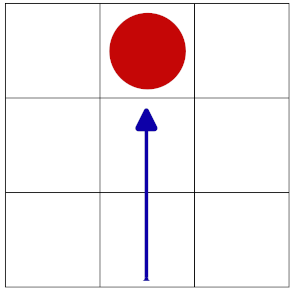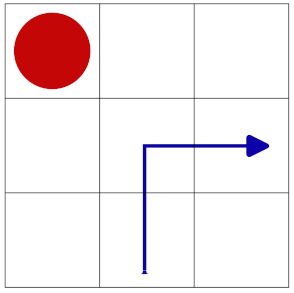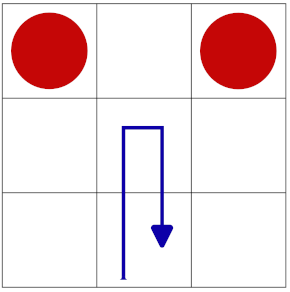Henning's Homepage |
The Blog
ON THIS PAGE
- True Black Box
- The Most User-Friendly Theorem Tester
True Black Box
2024-11-24 [PDF] [PERMANENT LINK]Here are the rules for the game True Black Box, my variant implementation of the board game Black Box.
1. Objective
The objective of True Black Box is to find the hidden locations of the particles in the box. This is done by repeatedly firing a laser beam into the box, take note of where the beam exits or if it doesn't exit at all, and form hypotheses about where the particles are based on these clues.
2. Interface
The interior of the black box is divided into 64 cells–the black squares on the board–in an 8x8 grid. The contents of these cells can never be viewed directly. (This is what makes the box a "black box.") Clicking a cell once marks it hypothetically as being empty. Clicking it twice marks it as containing a particle. The actual content of the cell is not affected by marking it in this way.
Along the edges of the grid are gray, numbered squares signifying entry points into the box. Clicking a gray square fires a laser into the box at that point, indicated by a green pulse. If the laser exits the box, this is indicated by a red pulse at the exit point.
Below the box is a table where test results are automatically entered. Each row contains the test number, the entry point of the laser and the exit point or N/A if the laser did not exit, and finally the time between the firing and the exiting of the laser or again N/A if the beam did not exit.
Above the box is the string identifying the box configuration that is currently being investigated. A random string is generated at the start of the game, but the player can also enter a specific string here. There is as well a button for starting a new game.
3. Rules
Each configuration contains between 3 and 5 particles at random hidden locations.
The player must fire laser beams into the box and form hypotheses about the location of particles, based on what happens to the beam and the player's knowledge of the laws governing how laser beams interact with particles inside the box.
The following laws determine laser beam behavior.
Absorption

If the beam hits a particle head on, it's absorbed and won't exit the box.
Deflection

If the beam encounters a particle diagonally in front of it, it's deflected 90 degrees in the opposite direction.
Double deflection

If the beam encounters one particle on each side diagonally in front of it, it's deflected twice 90 degrees and returns in the direction from which it came.
Reflection

If there is a particle right next to the beam's entry point on the edge of the box, the beam is reflected back out through the same point.
A beam can of course interact repeatedly with particles as it traverses the inside of the black box, and thus take a complex path. The time reported in the test log can be a hint as to how complex this path was.
Each play session constitutes one research project. The project, like all research projects, has limited funds, and can only afford to perform 10 experiments, after which the player needs to draw their conclusions from the data they have collected.
After the project is concluded the player must write up their results in short order and submit them to a high-ranking scientific journal, or they will be punished with extra teaching duties.
4. Strategies
There are three types of tests, or experiments, the player can use to reveal the contents of the black box.
Exploratory test
This consists in simply firing a beam into the box and noting the result, unguided by any hypotheses. At least at the very start of the game exploratory testing is required as there is no data to base hypotheses on. The result of the exploration can often be used to form a hypothesis about whether some cells contain a particle or are empty.
Hypothesis testing
Once there is some data, the player might form a hypothesis about whether certain cells in the box are empty or contain particles, and mark them as such on the board. The player can then construct a new test whose outcome is predictable given the truth of the hypothesis. If the outcome is as predicted, this adds support to the hypothesis, while if the outcome is different from the prediction this suggests that the hypothesis is wrong.
Testing the fitness of the hypothesis
Perhaps halfway through the play session and again at the end of it, the player should check how well the current hypothesis as marked on the board fits with the test results. For each result in the table, the hypothesis may explain the result, the result may contradict the hypothesis, or the result may be neutral as regards the hypothesis.
If some past test result contradicts the hypothesis–that is, that result is impossible if the hypothesis is true–then the hypothesis must contain some error. If all results are explained by the hypothesis, then that is strong confirmation of the truth of the hypothesis. Finally, if there are test results that don't contradict the hypothesis but are also not explained by it, then something is missing from the hypothesis.
5. Revealing the true configuration of particles in the box
In real-world science there is no key to the right answers. We can't flip the card over to see if we made the right guess. This is also how True Black Box works. It's what makes it a true black box, in contrast with the classic game. This may seem very disappointing to a player, but it shouldn't be. It means that at the end of the game, you must make a judgment as to how certain you are of your hypothesis, and that is an essential part of science.
For most box configurations it's possible to arrive at a hypothesis that the player can be certain is correct, if the ten tests were all well thought through. That is, it should be possible for the player in these cases to prove to themselves and others that the provided hypothesis must be true.
For some configurations this is not possible. It could be that some part of the board is inaccessible to tests, because it is surrounded by particles, for example. Identifying such a situation and being able to explain it is also a win for science. All we can do is maximize the information we are able to infer from the evidence, and that is the real goal of the game.
6. Real science is harder than this
In real science we can never prove that our hypothesis, or theory, or explanation is correct. We can point to two aspects of this game to illustrate why.
First, in the game we are told exactly what the laws are that govern the laser beam's interactions with particles. This information is necessary for proving that a certain hypothesis must be correct. But in real science the laws themselves are hypothetical! Imagine starting out with a black box and knowing neither the locations of particles nor what the relevant laws are. Progress seems impossible. But in real science we are not confined to one black box, but can reason by analogy from other areas of research we already think we understand. For example, in early particle physics there was an assumption that microscopic particles behaved like macroscopic objects, in accordance with Newton's laws. This assumption proved to be wrong, but it was a starting point. The point I want to make here is just that we never have absolutely certain knowledge of any part of the system we are investigating, and that makes it impossible to prove our results with logical certainty.
Second, in the game the outcomes of experiments always conform exactly to the given laws, without any random deviations. This is also not how the actual physical world works. In any real experiment there is the possibility of error and "noise." This introduces yet another source of uncertainty. If the outcome of an experiment is not as predicted when we perform a hypothesis test, this may be because the hypothesis is false, but it may also be because something went wrong with the experiment. Again, we rely on our overall understanding of the instruments we use and of related parts of science to make a judgment as to what is the most likely reason we got the outcome that we observed. But again, this makes it impossible to definitively prove our results.
Real science is harder than True Black Box, but it's not impossible. In particular, the fact that we can't logically prove the truth of our results in science doesn't imply that we can't genuinely know anything. What matters in science is the sum of the evidence speaking for or against our theory, and that evidence can be so strong as to eliminate all reasonable doubt, as is the case with large parts of our modern scientific understanding of our world and ourselves.

The Most User-Friendly Theorem Tester
2024-11-13 [PDF] [PERMANENT LINK]These are the instructions for the Most User-Friendly Theorem Tester (MUFT) for propositional logic.
A row beginning with 'p:' contains a premise. A row beginning with 't:' provides a proposition to be tested. Rows beginning with neither are ignored. The program tests for each of the test propositions whether it follows from the given premises. If it does, the program says so. If it doesn't, the program provides a counterexample. The counterexample is given by stating all and only the true atomic propositions.
MUFT uses Reverse Polish Notation (RPN). This is very convenient when writing the program–not so convenient when using it! (Yes, the name of the program is ironic.)
Also, for ease of parsing, the following single characters are used for the logical connectives:
| Negation | ~ |
| Conjunction | & |
| Disjunction | | |
| Implication | > |
| Equivalence | = |
As a propositional variable, any upper or lower case letter from the English alphabet can be used. (But at most 12 variables in any run. And a variable can only consist of a single letter.)
Here are som example logical expressions:
| Normal | MUFT |
|---|---|
| A -> B | AB> |
| (P & Q) v R | PQ&R| |
| P & (Q v R) | PQR|& |
| (r -> s) <-> (~s -> ~r) | rs>s~r~>= |